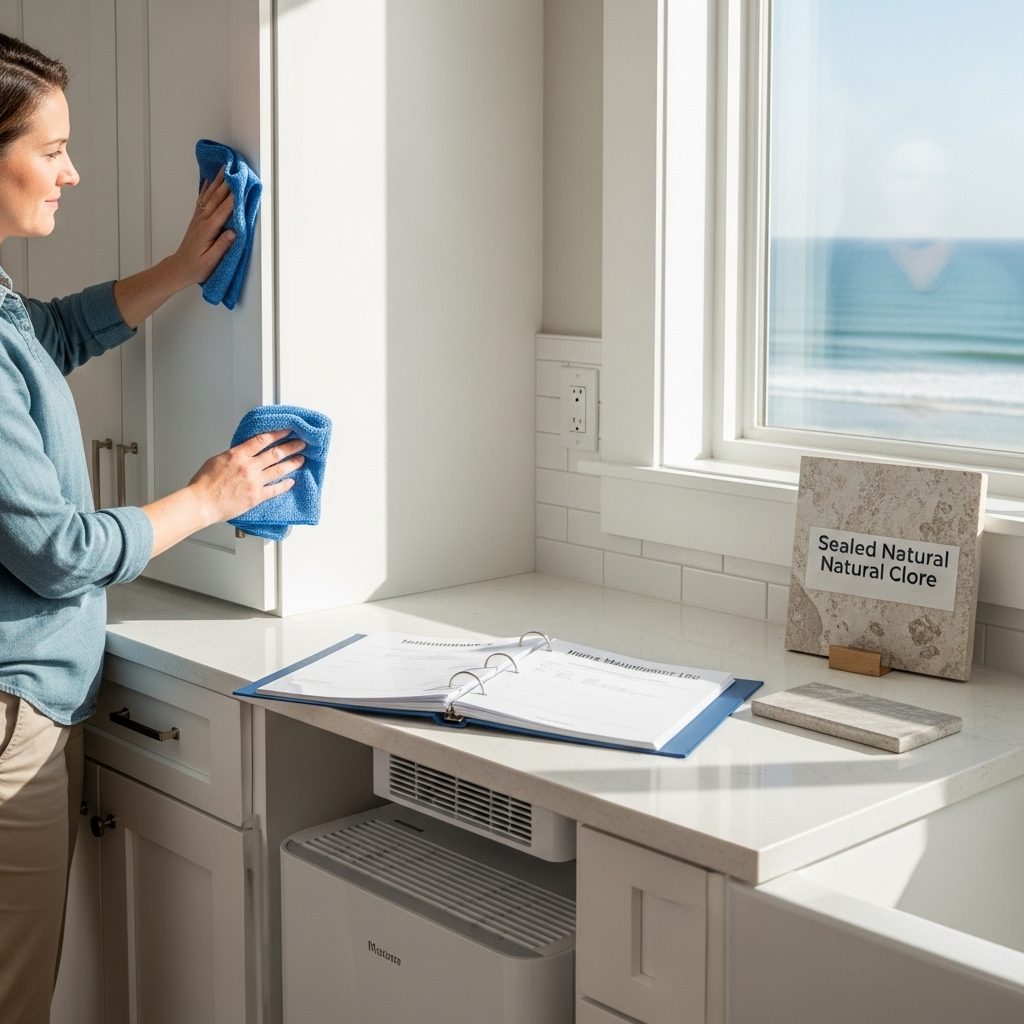A newly remodeled kitchen in Huntington Beach, California deserves care that keeps it looking stunning and performing flawlessly for years. With sun, salty air, and sandy traffic, coastal life adds special maintenance considerations. This guide delivers a practical routine for surfaces, fixtures, appliances, and finishes so you can preserve beauty and function long after the last contractor leaves. If you want a maintenance plan built into your project from the start, collaborate with a team that treats long-term care as part of expert kitchen remodeling.
Set Up a Maintenance Binder
Organization is the foundation of easy upkeep. Create a binder—or a digital folder—containing appliance manuals, warranty information, finish schedules, and color codes. Add receipts and contact information for installers. Keep a log for filter changes, grout sealing, and any repairs. Having this information at your fingertips ensures you follow manufacturer recommendations and stay ahead of small issues.
- Include paint colors, sheens, and brands for quick touch-ups.
- File tile and grout specifications with recommended sealers.
- Record serial numbers and purchase dates for appliances.
Countertop Care by Material
Countertops work hard. The way you care for them depends on the material. For nonporous surfaces like quartz, daily cleaning with a soft cloth and mild soap is usually enough. Avoid abrasive pads. For natural stone, use pH-neutral cleaners and follow sealing schedules recommended by the fabricator. Sintered or porcelain slabs are highly durable but still benefit from gentle cleaning practices that avoid harsh chemicals.
- Use cutting boards and trivets to protect all surfaces.
- Wipe spills promptly—especially acidic substances like citrus and vinegar.
- Follow your fabricator’s guidance for sealers and re-sealing intervals.
Backsplash and Grout Maintenance
Backsplashes are exposed to steam, oil, and splatter. Regularly wipe with a mild cleaner compatible with your tile. Where grout is present, apply a penetrating sealer if recommended for your material and touch it up periodically. For glass or glazed ceramic, use non-abrasive cleaners to maintain clarity and shine. Pay particular attention to areas behind the cooktop where residue accumulates fastest.
- Clean along edges and corners where grease can build up.
- Use a soft brush to gently scrub textured tiles.
- Reapply grout sealer on a schedule suited to your tile and grout type.
Cabinetry: Finish Protection and Function
Cabinets receive constant handling. Clean with a damp, lint-free cloth and dry immediately. Avoid soaking hinges or soft-close mechanisms. In coastal environments, periodic inspection for oxidation on hardware is smart. Touch up minor dings with matching finish kits and tighten loose handles as needed. For wood finishes, keep humidity within a stable range to reduce expansion and contraction.
- Install felt pads on doors that contact walls or panels.
- Lubricate hinges sparingly if they squeak, using appropriate products.
- Keep sink base areas dry and use liners to catch drips.
Flooring that Stands Up to Sand and Moisture
Floors take the brunt of coastal living. Use entry mats to capture sand and water near doors and the garage. Sweep or vacuum frequently with a hard-floor attachment to prevent grit from scratching surfaces. For tile, clean grout lines regularly and reseal if needed. For engineered wood or luxury vinyl, use manufacturer-approved cleaners and avoid standing water to protect seams and finishes.
- Protect high-traffic zones with washable runners.
- Place soft pads under stools and chairs to prevent scratches.
- Address spills immediately to avoid swelling or staining.
Appliance Care and Efficiency
Appliances last longer with routine attention. Clean refrigerator coils, replace water filters on schedule, and wipe gaskets to maintain a good seal. For dishwashers, run a cleaning cycle and check spray arms for debris. Keep oven interiors clean according to manufacturer guidance and verify ventilation is operating effectively to reduce heat and humidity in the kitchen.
- Empty and clean range hood filters regularly.
- Confirm exterior vent caps are free of salt and debris.
- Run the dishwasher with a cleaning agent to remove buildup.
Ventilation: Your First Line of Defense
Proper ventilation does more than clear cooking smells; it protects finishes from moisture and grease. Use your range hood whenever you cook and allow it to run for a few minutes after finishing. In Huntington Beach, exterior vent caps and ducting can experience salt exposure; inspect and clean them on a schedule. Keeping airflow unobstructed supports indoor air quality and preserves surfaces.
- Choose an appropriate setting on the hood for the cooking task.
- Wash or replace filters per manufacturer intervals.
- Inspect ductwork joints and exterior terminations annually.
Plumbing Fixtures and Water Protection
Sinks, faucets, and dishwashers face constant use. Check for slow leaks under the sink, around shut-offs, and at dishwasher connections. Clean mineral deposits with a gentle, compatible solution. Use caulking around sink rims and backsplashes to keep water out of seams. Swap out aerators if flow decreases, and flush lines after maintenance to clear debris.
- Use sink mats or grids to protect basins.
- Wipe water from counters near seams after heavy use.
- Keep a flashlight in your maintenance kit for leak checks.
Lighting and Electrical Upkeep
Lighting sets mood and function. Dust fixtures, wipe lenses, and check dimmer performance. Replace bulbs with the same color temperature to maintain consistent ambiance. Inspect under-cabinet lights and cords for wear. Label your electrical panel clearly so future troubleshooting is fast and safe.
- Keep spare bulbs of the correct color temperature on hand.
- Test GFCI outlets and reset if needed.
- Secure any loose faceplates to protect wiring.
Seasonal Care for Coastal Kitchens
Seasonal maintenance helps you stay ahead of wear. After stormy periods, check exterior vents and doors for drafts or moisture. Clean window tracks and ensure weatherstripping is intact. Reevaluate rugs and entry mats, replacing them if they hold moisture or sand. Adjust your cleaning routine during summer when windows are open and breezes carry salt indoors.
- Deep-clean grout and reseal as recommended.
- Inspect cabinet doors and drawer fronts for alignment.
- Rebalance refrigerator doors if gaskets are not sealing evenly.
Protecting Metal and Hardware in Marine Air
Hardware finishes can suffer in salty environments. Wipe handles, pulls, and hinges regularly with a soft, damp cloth and dry immediately. Avoid harsh chemicals that can strip finishes. For stainless steel, clean with a microfiber cloth along the grain and use a compatible polish sparingly. If you notice early signs of corrosion, address them quickly to prevent deterioration.
- Keep a gentle stainless cleaner in your maintenance kit.
- Wipe appliance handles daily in high-use seasons.
- Choose corrosion-resistant finishes for any replacements.
Organizing and Decluttering for Longevity
Clutter accelerates wear and makes cleaning harder. Use drawer dividers and pull-outs to keep tools accessible. Rotate pantry items to prevent spills from forgotten goods. If your household brings in sand and gear from the beach, designate baskets or bins near entries to isolate mess before it reaches the kitchen.
- Install pull-out trash and recycling to streamline cleanup.
- Use liners in drawers holding oils or spices.
- Schedule a quarterly declutter to reset the space.
Eco-Friendly Practices That Also Protect Finishes
Many sustainable habits also extend the life of your kitchen. Microfiber cloths reduce the need for harsh chemicals, and gentle cleaners protect finishes while being kind to the environment. Opt for energy-efficient appliance settings that reduce heat output, and use lids while cooking to minimize humidity and grease dispersion.
- Ventilate while cleaning to support indoor air quality.
- Choose low-VOC products for touch-ups and maintenance.
- Use concentrated, manufacturer-approved cleaners to reduce waste.
Creating a Weekly, Monthly, and Annual Maintenance Rhythm
Break tasks into simple intervals so nothing is overwhelming. Weekly, wipe counters and cabinets, vacuum floors, and run the hood filter through a quick wash if you cook frequently. Monthly, check for leaks, clean appliance gaskets, and review your supply of maintenance items. Annually, deep-clean grout, reseal porous surfaces, service appliances, and inspect exterior vent caps.
- Set calendar reminders for filter changes and sealing tasks.
- Keep a small toolbox and maintenance kit in an accessible cabinet.
- Log completed tasks so you can track trends and plan proactively.
FAQs
Q: What’s the most important maintenance task in a coastal kitchen?
A: Ventilation care is crucial. Clean range hood filters, check exterior vent caps, and ensure ductwork is clear. Good airflow protects finishes from moisture and grease.
Q: How often should I reseal natural stone?
A: Follow your fabricator’s guidance. Some stones need annual sealing, while others require less frequent maintenance. Test by placing a few drops of water—if it darkens quickly, it’s time to reseal.
Q: How can I prevent hardware tarnish or corrosion?
A: Wipe regularly, avoid harsh chemicals, and choose corrosion-resistant finishes. In high-salt seasons, add an extra quick wipe to your daily routine.
Q: What’s the best way to protect cabinets near the sink and dishwasher?
A: Use liners in sink bases, wipe water immediately, and maintain caulk lines. Ensure good ventilation and dry any standing moisture after heavy use.
Q: Do I need professional help for maintenance?
A: Many tasks are DIY-friendly, but periodic professional inspections and service can extend appliance life and keep ventilation performing at its best.
Bring Lasting Beauty to Your Huntington Beach Kitchen
With a thoughtful routine and the right products, your remodeled kitchen can handle sun, salt, and everyday life while staying beautiful. Organize your maintenance binder, schedule simple recurring tasks, and act quickly when you spot issues. If you prefer expert guidance and service plans tied to your specific finishes and appliances, explore comprehensive, care-focused kitchen remodeling support and keep your coastal kitchen performing at its peak.

